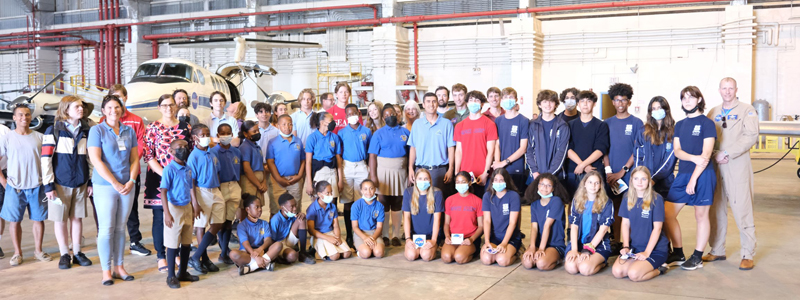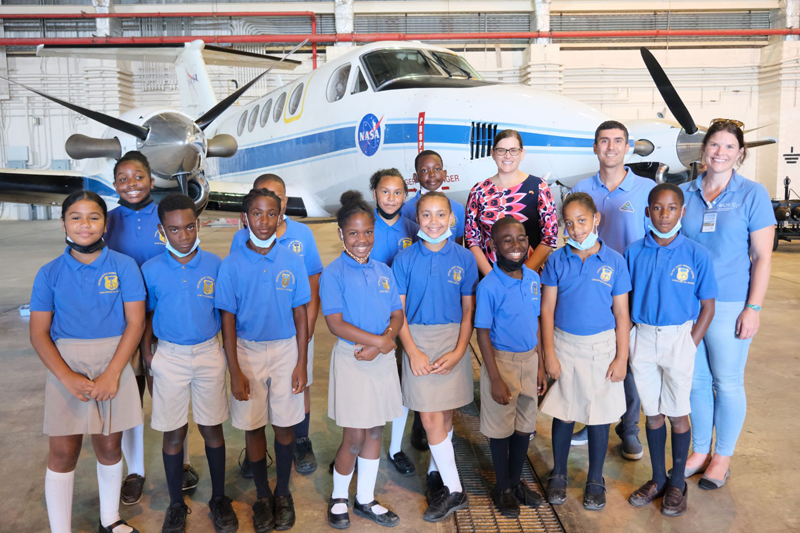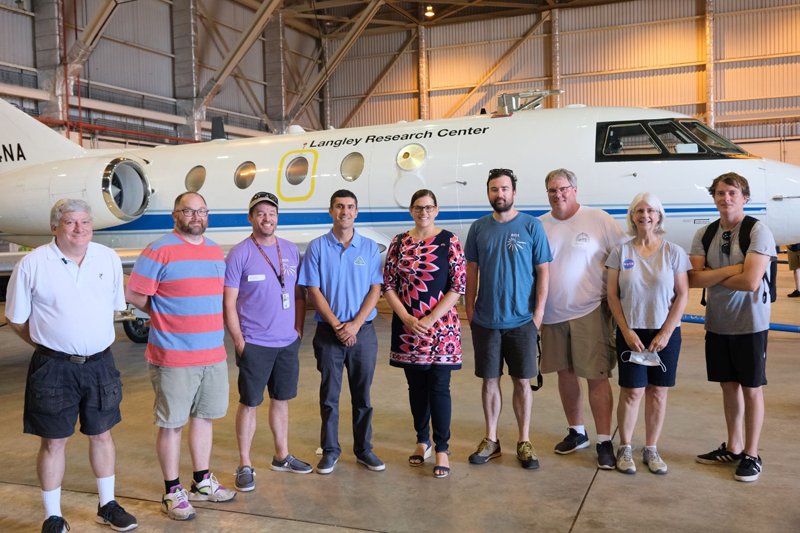Students Learn From NASA Mission In Bermuda
The Bermuda Institute of Ocean Sciences’ [BIOS] Ocean Academy helped coordinate a unique learning opportunity for local schools when a NASA science mission moved its flight operations from the U.S. to Bermuda for three weeks beginning earlier this month.
A spokesperson said, “The Aerosol Cloud meTeorology Interactions oVer the western ATlantic Experiment [ACTIVATE] mission aims to develop large data sets to improve global climate change models.
“Specifically, the ACTIVATE team is studying how clouds interact with aerosols. These tiny particles in the atmosphere come from a variety of sources, including pollution, sea salt spray, even dust blown across the ocean from the Sahara Desert, which can eventually make its way to the sky above Bermuda.
“The amount, size, and type of aerosols all play a role in their potential impact on clouds, triggering them to condense into rain, changing the amount of sunlight they reflect back into space, or reducing their time in the atmosphere.
“Forty students from Saltus Grammar School, Victor Scott Primary, and Warwick Academy visited Armin Sorooshian, atmospheric scientist at the University of Arizona and principal investigator of the ACTIVATE mission, and the ACTIVATE team at the Longtail Aviation Facility in St. George’s. Over the course of an hour, students heard about mission goals, boarded one of the aircraft, viewed the research instruments and learned what data each piece is responsible for collecting, and were encouraged to ask questions along the way.”
Armin Sorooshian, atmospheric scientist at the University of Arizona and principal investigator of the ACTIVATE mission, said, “Clouds play a major role in climate change models because they both cool and warm Earth’s surface, but cloud-aerosol interactions remain one of the biggest unknowns in this field of research.
“ACTIVATE uses two aircraft outfitted with remote sensing and in-situ instruments that simultaneously collect data from above, within, and below the clouds.” Using this approach, the goal is to capture enormous amounts of data throughout the air column on repeat flights—179 in total by the end of the ACTIVATE mission.”
The spokesperson said, “The first five airborne deployments, which began February 2019, were based out of NASA’s Langley Research Center in Hampton, Virginia [U.S.]. For the sixth and final deployment, between May and June, the ACTIVATE mission brought its research aircraft, along with a team of engineers, pilots, project managers, and scientists to Bermuda.
“On Thursday, June 9, approximately 40 students from Saltus Grammar School, Victor Scott Primary, and Warwick Academy visited Sorooshian and the ACTIVATE team at the Longtail Aviation Facility in St. George’s. Over the course of an hour, students heard about mission goals, boarded one of the aircraft, viewed the research instruments and learned what data each piece is responsible for collecting, and were encouraged to ask questions along the way.”
Primary students from Victor Scott, along with U.S. Consular General, Karen Grissette, Armin Sorooshian with University of Arizona, and Kaitlin Noyes from BIOS
Kaitlin Noyes, BIOS director of education and community engagement, said, “We were thrilled when Armin offered Ocean Academy students the opportunity to meet with members of ACTIVATE mission and tour the planes at the Longtail Aviation hangar.
“The hands-on interaction with the researchers and pilots fueled so many different questions, from engineering to weather to what it’s like to live and breathe on a NASA field mission.”
The spokesperson said, “Joining the event was U.S. Consul General Karen Grissette, who used the opportunity to highlight the United Nation’s World Oceans Day, held each year on June 8, and to join U.S. celebrations in June for National Ocean Month.”
U.S. Consul General Grissette said, “Bermuda’s environment and strategic location play a key role in climate and ocean research. We were honored to share NASA ACTIVATE’s mission with Bermudian students so they could see that firsthand. The visit highlighted NASA’s continued partnership with Bermuda, and NASA’s commitment to providing access to education outreach opportunities.
“The U.S. government is a leading supporter of BIOS, and we are grateful to BIOS for connecting us with students to explore NASA ACTIVATE’s airborne research stations. Bermudian students had the opportunity to ask questions of leading global climate scientists and engineers. On behalf of the United States research community, we are so proud of the important scientific partnerships we have in Bermuda.”
Richard Ferrare, Luke Ziemba, Dave Harper [NASA Langley Research Center], Armin Sorooshian [University of Arizona], Karen Grissette [U.S. Consul General], Taylor Shingler, Johnathan Hair, Marta Fenn, Brian Collister [NASA Langley Research Center]
The spokesperson said, “Inspired by seeing the ‘amazing engineering that went into each electrical, physical, and data-collecting component’ of the mission, Saltus Graduate Year 1 [U.S. grade 11] student Oscar Harrison, 17, asked to join the ACTIVATE team in their ground control room.”
Mr. Harrison said, “The team was incredible. I had the pleasure and privilege of talking to the pilots, research team, and mission control. I was able to watch the experiment take place live, saw all the data come back, and even shared some ideas as to what aerosols might be found. Every question I had for them was answered.”
The spokesperson said, “The ACTIVATE mission highlights the important role that Bermuda plays in atmospheric science research. The island is a distinctive study site due to its geographic location, which causes it to be impacted by multiple sources of man-made and natural aerosols and gases depending on daily and seasonal changes in atmospheric circulation.
“Since 1988, BIOS has operated the Tudor Hill Marine Atmospheric Observatory, currently supported by the U.S. National Science Foundation, which collects data year-round on the chemical and physical properties of the atmosphere. In addition to routine sampling activities, such as meteorological data and carbon dioxide concentrations, the Tudor Hill instruments also sample for aerosols. Gas and aerosol data from Tudor Hill were utilized to support two ACTIVATE journal publications last year.”
Mr. Sorooshian said, “It’s rare to find an island laboratory with such rare, high-quality data that can be used to address some of the most pressing questions in ocean-atmospheric research.”
Read More About
Category: All, Environment, News, technology





